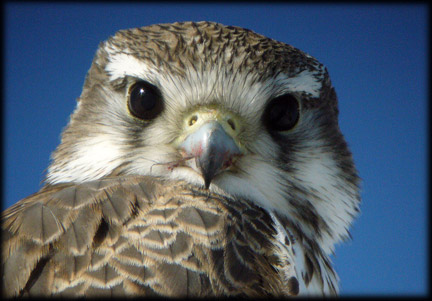Last weekend I led a Denver Field Ornithologists trip in search of White-tailed Ptarmigan in the Indian Peaks Wilderness west of Boulder. This was a snowshoe birding trip, and with a foot of fresh snow they were absolutely required to get around. We 'shoed up to treeline, ticking only 3 birds (Mountain Chickadee, Golden-crowned Kinglet, and Red-breasted Nuthatch) along the 2-mile climb through the subalpine forest, but we were dazzled with the snow-draped spruces, firs, and pines. As we got glimpses of the Indian Peaks through the trees I knew we were going to face harsh conditions above treeline, though, as wraiths of snow were being whipped high above the ridge lines by strong winds. Sure enough, as we overtopped the dam at Left Hand Reservoir, we were blasted by gusts of 25-30 mph. I brought along a Kestrel weather meter that registered 6.8° F. At that combo the wind chill is around -15° F. More importantly, White-tailed Ptarmigan deal with harsh conditions in an efficient way, staying cozy by scrunching down into the snow and letting it drift over them. Without tracks to indicate areas of recent activity or birds above the surface to scan for our odds were pretty slim but we tried for a while anyway, snowshoeing around the stunted willow groves were they winter, dining on wind-exposed buds. After a valiant effort we decided that keeping all of our fingers and toes was more important and headed back down sans ptarmigan. It was hard work for 3 species of birds but a dazzling day in the Colorado high country! Thanks to the 8 hardy birders who joined me on the quest- maybe we'll have better luck next time.

 Peering up at a Golden-crowned Kinglet
Peering up at a Golden-crowned Kinglet


 Trooping Up (Last pic courtesy of Dave Alcock- that's me in front.)
Trooping Up (Last pic courtesy of Dave Alcock- that's me in front.) Wind-whipped snow flying off Mt. Audubon
Wind-whipped snow flying off Mt. Audubon
 Krummholz zone
Krummholz zone Looking back at my tracks across Left Hand Reservoir. Two specks in the distance are Ed and Dave who searched the longest and hardest- thanks for trying, guys!
Looking back at my tracks across Left Hand Reservoir. Two specks in the distance are Ed and Dave who searched the longest and hardest- thanks for trying, guys! Wind-whipped snowshoe-birders (photo by Dave Alcock- thanks again, Dave!)
Wind-whipped snowshoe-birders (photo by Dave Alcock- thanks again, Dave!)










